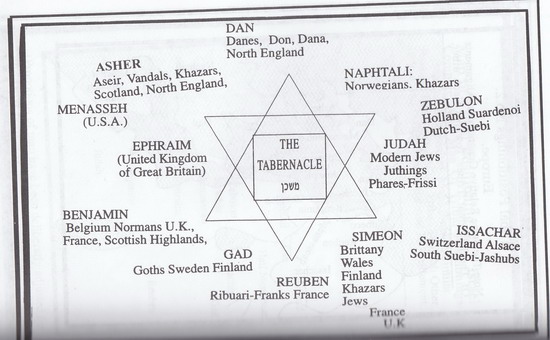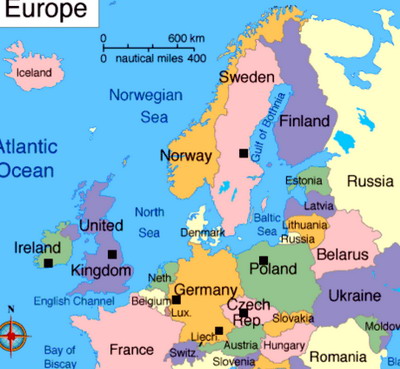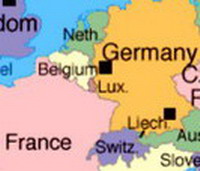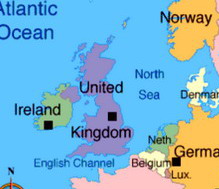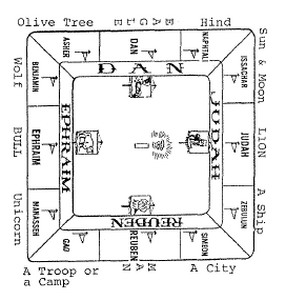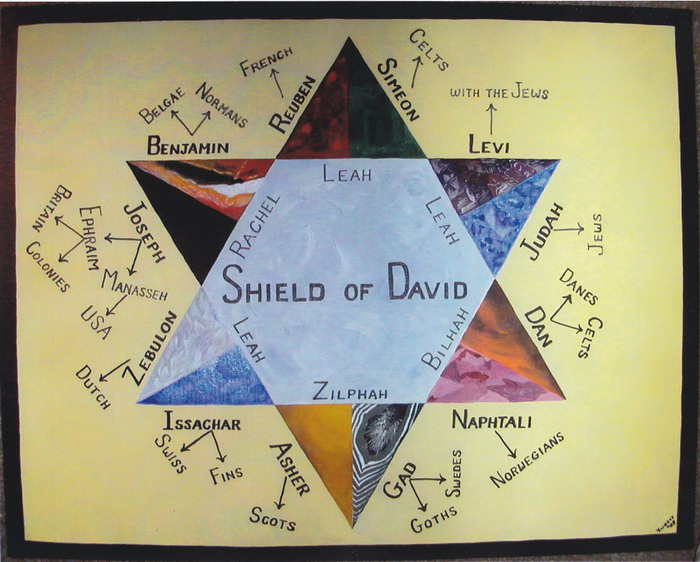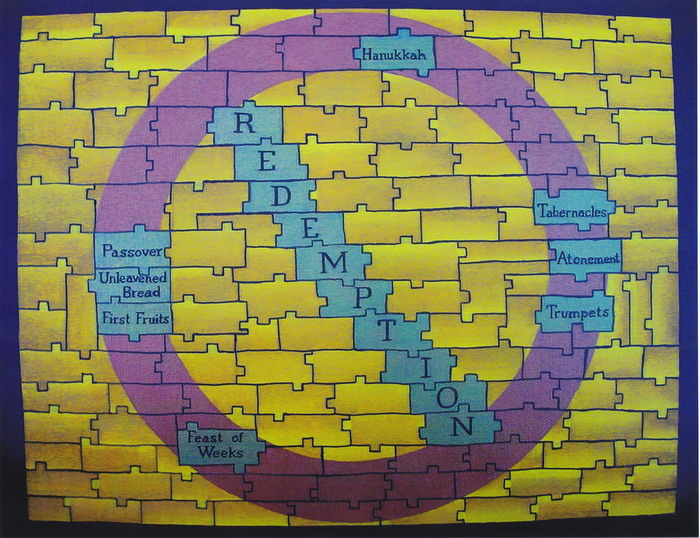|
Adapted from "The Tribes"
Introduction
The present account concentrates on identifying Israelite
Tribes and Tribal clans with groups who amalgamated with other entities to
eventually form present day nationalities. Some aspects of the historical
associations of the individual tribes and their equivalents are indicated in the
order of encampment in the wilderness. The children of Israel when they came out
of Egypt were destined to wander in the wilderness for forty years before
entering the Promised Land of Israel. In the wilderness The Tribes were encamped
in a specified order around the Tabernacle (Numbers chapter 2) and similarly on
marching forward they were to proceed in the same order of march with the group
belonging to Judah going first and that connected with Dan following behind at
the end (Numbers ch. 10). The camping arrangement divided the Twelve Tribes
into four groups of three and these groupings have historical significance of
their own. The camping alignment has some parallelism to the Familial order of
Jacob and his wives (whose importance is referred to elsewhere) but not an exact
one.
Judah,
Issachar
and Zebulon
Judah was to camp in the east together with Issachar and Zebulon. In
history distinctly separate groups, both identified with Suebi though basically
different, were to settle in Switzerland and the Netherlands (Holland). The settlers in
Switzerland were from Jashub son of Issachar whereas those identified as Suebi
in Holland were actually a people known as Suardenoi from Sered son of Zebulon.
Issachar was to dominate Switzerland, Zebulon -Holland; but groups from both
Tribes were found in each country. Alsace was settled by the Alemanni whose name
was often used synonymously with that of the Alans who in part settled in
Switzerland and were named after Elon son of Zebulon whereas the Alemanni-proper
were a branch of the Suebi and came from the Jashubi (Suebi) of Issachar.
Amongst the Alemanni of Alsace were the Juthones whose name is reminiscent of
that of the Jutes from Jutland of Denmark and both peoples descended from Judah.
The Jutes at one stage had a center in the region of Holland amongst the
Frisians part of whom may have come from Pharez son of Judah.
More on Alsace: Dreyfus
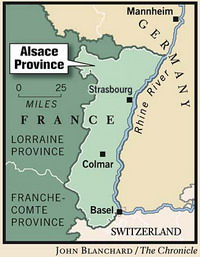 |
Alsace is on the border with Switzerland and lies between France and Germany.
Alsace was considered a German speaking region though actually in Alsace and the
region local dialects were used that nobody else could understand and that have
not been studied properly. Alsace had been appropriated by France and was
basically French in sentiment. Germany and France struggled for control of
Alsace though most of the Alsatians considered themselves French.
In 1870 the Germans defeated France and took over Alsace which they ruled until 1918.
|
Alsace was also an area in which many Jews had settled since Roman times.
The
Jews in Alsace had often not been treated well though there were exceptions.
[
The Gentile inhabitants of Alsace appear to be of mixed Israelite,
Edomite,
and other origins.]
Despite the conquest of Alsace by Germany many Alsatians became
prominent in the French Army. One of these was Alfred Dreyfus whose family came
from Alsace and who himself was of Jewish origin and an officer in the
1890s. Dreyfus was suspected of spying for Germany. Evidence was forged
against him and he was convicted. Shortly afterwards it became quite clear that Dreyfus
was not the guilty party but rather a certain Esterhazy (who was of Hungarian origin) was the real culprit. Neverthless it
had been decided to "sacrifice" Dreyfus for nationalistic reasons.
[
Present-day Conspiracy Freaks in their attacks against the Jewish and Anglo
peoples often take on the characteristics of those who attacked Dreyfus. The
family of Yair
Davidiy
on his mother's side was probably distantly related to Alfred Dreyfus.]
The Dreyfus case became the subject of contention between
progressive and reactionary elements in France. Many people who considered
themselves to be patriotic and conservative were against Dreyfus on principle
despite concrete evidence that confirmed his innocence. There were however
amongst the strongest defenders of Dreyfus many upright Conservative elements as
well as many French Huguenot Protestants. Alsace had once been a Huguenot center though Catholics had always been in the majority.
On the whole relationships between Jews and Huguenots were good ones.
Dreyfus knew his
only crime was having been born a Jew. Because he was Jewish however all the
Anti-Semites condemned him. The Army also was against him. Dreyfus himself was
fanatically pro-French and so was his family. New evidence came to light proving yet again
that Dreyfus was innocent and in fact had been framed. The Army and the Establishment however at this stage had difficulty backing down and abandoned
Dreyfus to serve his sentence. Eventually the innocence of Dreyfus was
acknowledged though even to the present day Jews are not really welcome in the French Army.
The Germans later conquered France in the Second World War. They
were assisted by traitors within France. In very many cases those who betrayed
France were the physical and spiritual heirs of those who had falsely accused
Dreyfus and been prominent in the attacks against him. The Dreyfus case inspired
Theodor Herzl to found the Modern Zionist Movement. This helped lead to the
creation of the State of Israel. The Dreyfus case is important because it
encapsulates several important "identity" concepts. One section of the
Israelite family cannot loyally assert itself at the expense of another. Any
such attempt will cause the perpetrator to achieve the opposite of what he
believes himself to want.
Reuben, Simeon and Gad
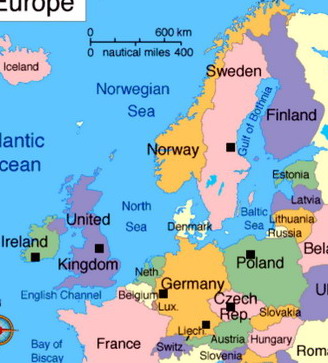
| | Note:
If one elminates the non-Israelite entities then Finland, Sweden, and France are in one line and comprise (with Switzerland)
the easternmost bloc of Israelite nations in western Europe.
The settlement of the Tribes in the Land of Israel was somewhat different from that around the Tabernacle
though here too a certain parallelism exists and the actual positioning in Europe combines aspects of both.
|
After the trio led by Judah, came that to the south headed by
Reuben, who was encamped together with Simeon and Gad. Reuben was to become the
Ribuari Franks who gained control of France including the area of Brittany. In
French Brittany were the Samnites from Simeon and the Namnites (from Namuel, son
of Simeon) according to Ptolemy in ca. 120 CE. Much later, in the late 400's
and 500's, the area of Brittany was to be conquered and populated by people from
Wales and Celtic Britain who were being pushed out of Britain by the
Anglo-Saxon advancements.
The peoples of Celtic Britain and Wales who re-populated Brittany
also included descendants of Simeon. Simuen was the name of the Celtic-British
forefather in Irish Literature which also referred to the Welsh as "Simeni", as
we have seen. Ptolemy placed the SIMENI on the east coast of Britain in an area
close to that of the ICENI whose name resembles a Phoenician rendition of the
name Yachin, son of Simeon. The Silures of South Wales came from Shaul, son of
SIMEON, son of Israel.
The Tribe of Gad gave rise to the Goths and the close relationship
of the Goths and their offshoots with those of the Franks both in Scythia and in
Western Europe are discussed elsewhere. This closeness was so great that
sometimes it is difficult to distinguish between the two. An example was the
Chauci (Hocings) of Hugo (Frank) association who was either descended from Haggi
son of Gad or from Henoch son of Reuben, or a combination of both.
The Goths (of Gad) became the most important people in Sweden and
also were influential in Finland. The Finns call themselves Suomi which name may
originally have been a form for Simeon though later modified to give it a
meaning comprehensible in the local dialect. The Finns once regarded themselves
as descendants of the Lost Ten Tribes of Israel1 as did the Khazars some of whom
spoke a Finnish language and in part are considered to have been a Gothic group.
Gad and Simeon were associated both in Finland and in Khazaria. The Goths also
once had a kingdom in Southern France which became dominated by the Ribuari and
other Franks of Reuben and so Gad, Reuben, and Simeon were influential in the
French kingdom.
Ephraim, Manasseh and Benjamin
The third trio described in the Book of Numbers (ch.2) in the
Israelite encampment was to the west. This was composed of Ephraim, Manasseh and
Benjamin, with Ephraim leading. Manasseh and Ephraim appear mainly to have been
found amongst the Celtic-Galatians many of whom settled in Britain and also
amongst the Anglo-Saxon hosts. Benjamin became the Belgae of Belgium and the Normans who conquered the
Anglo-Saxons and Celts of Britain and Ireland.
A Jewish Rabbinical Commentator
(the "Natziv" on Genesis 48:14) understood Ephraim's leadership to have been
more spiritual, whereas Manasseh was to gain the material-lead. Indications are
that Manasseh became the stronger element in the population of the U.S.A. and
Ephraim that of Britain, which conforms to the leadership distinction. Even so
there must be very many from Ephraim in the USA which has become a center for
all Israelite Tribes.
Dan, Asher and
Naphtali
| | 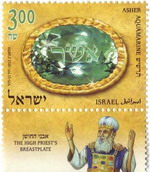
| |
The last of the four groups of three among the Israelite Tribes in the
wilderness was that to the north dominated by DAN who was together with Asher
and Naphtali. Dan became the Danes of Denmark and Naphtali became the Naphtali who migrated
to Norway. |
Elements from Dan and Naphtali also settled in Ireland.
Both Denmark and Norway produced the Vikings who invaded and settled
in Northern England in an area previously belonging to the Angles and Varin
(Vandals) and before them to the Brigantes.
These groups derived from the Tribe of Asher and moved northwards into Lowland scotland. The Aseir were considered
ancestral gods by the Scandinavians including those of Norway and Denmark. Since
the Aseir also came from the Tribe of Asher the alliance of Dan, Naphtali, and Asher
was retained and/or renewed both in Scandinavia and in Scotland and northern England.
Incidentally, in Celtic times the Children of Don from the Tribe of Dan had
settled parts of Britain. Their presence in the north is indicated by the Don
River and the city of Danum (Doncaster). This was the same area which the Danes
of Denmark were destined to occupy.
The above identifications show that the arrangement of the Camp was
to some degree parallel to the future geographical positions of the Tribal
descendants. What is more significant is that the triadic teams often reflected
a destined close association.
Similar Illustration from another
source:
|
